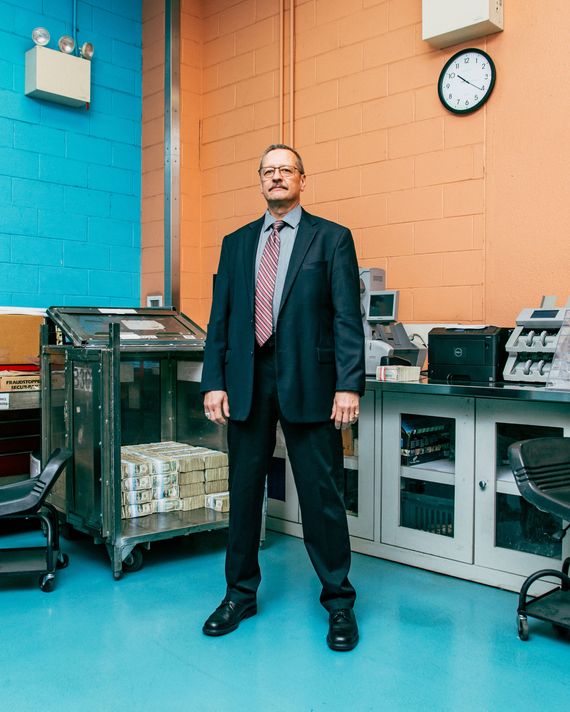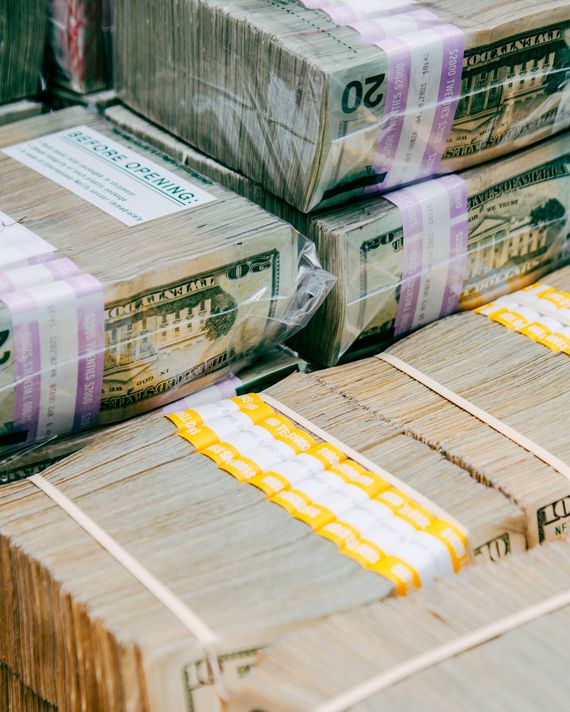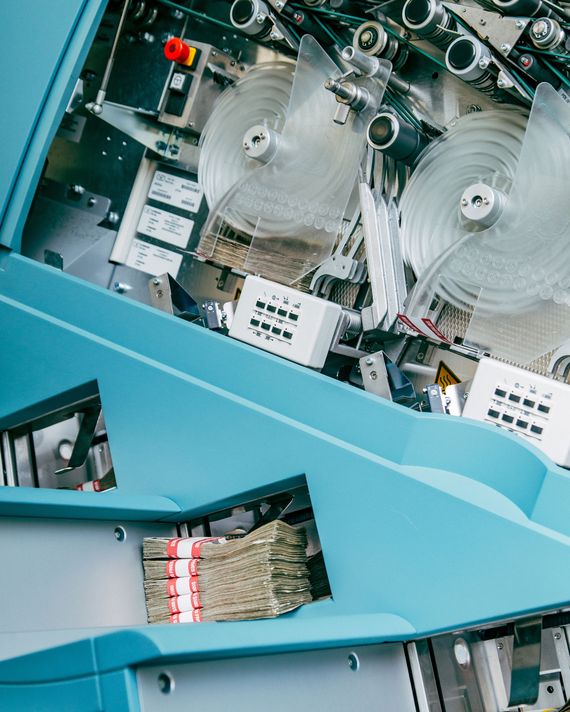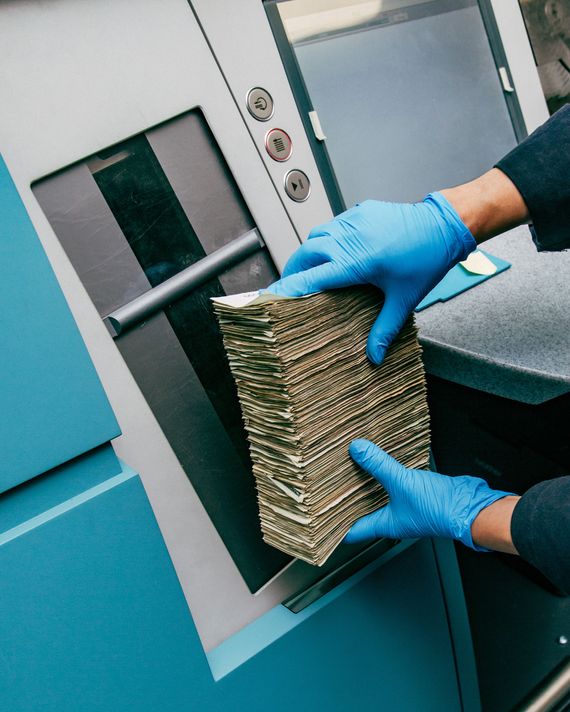
‘I got a couple of billion dollars rolling around through here,” Al Putre says, gesturing downward toward the floors below. We are sitting in the conference room next to his office, which is on one of the upper levels of a blocky, nearly unmarked building in southwest Queens. (He has asked me not to reveal where it is more precisely — “Call it a secret location. They like that” — although you can probably figure it out with Google.) On your way there, you pass mostly businesses that sell steel pipe and cinder blocks from behind barbed wire, plus the odd strip club. Every nickel’s worth of cash that comes into the MTA, and every MetroCard that goes out, passes through this building and thus under Putre’s eye. Although the agency’s income is down a lot owing to the pandemic, the amount of cash that passes through most years, give or take, is about $1.5 billion.
Putre talks fast — and I mean fast — in a Queens accent that is on the endangered-species list, and has a high-and-tight graying haircut that would not be out of place in a precinct house. He’s been with the MTA for 34 years, and in charge of the division of revenue — the money rooms and their associated operations — since 1999. On the day we meet, he’s a couple of days from retirement. He started in the era of subway tokens in cloth sacks and overnight runs of the money train; he wraps up his career managing a digital river of electronic payments and the launch of OMNY, the system that will soon replace the MetroCard. What he clearly loves, even more than the job or the agency or the piles of cash, is a system. Ask him about the change that riders drop into the farebox on the bus, which gets picked up at the depots and brought to the money room, and here’s what he’ll tell you, in the space of 90 seconds, incorporating a quick hallway encounter with a colleague:
“We suck all the money out of fareboxes via a Keene vacuum system. There’s only one other agency in the world I’m aware of that does that. Philly was at one time, but I’m not even sure if they do anymore. You need to have high volumes of coins and large numbers of buses. We fit that bill — Hey, partner, how are you? You’ll see the vaults here: They look old, they are old, but they last very, very well. They’re durable. And the system is set up so it’s sealed. So from the moment a bus pulls in, the money gets vacuumed out via a port, and that port is connected to a vacuum hose and a probe. The probe takes the data from the fare box, sends it up to the AFC [automated fare collection]. The vacuum sucks it up into the ceiling to a shaker-sorter, a sifter. The coin goes into the vaults by denomination. Why is that important? You can count separated coin extremely fast, 10,000 pieces per minute. If you get the coin unseparated and you have to sort it, the speed goes down to 2,500 pieces per minute, and it wears the machines out. The TA separating this coin makes this operation smooth as silk. You’ll see what I mean.”
And with that we proceed through locked doors, under closed-circuit TV and heat-sensor cameras that weren’t there until Al got them installed. Three sources of money feed the coin-sorting room: the aforementioned bus-coin-suckers at the depots, the subway’s token booths, and the MetroCard vending machines, which everyone here calls the MVMs.
It’s loud in here. Eight or so people sit or stand at stations in front of troughs, bins, pipes, all moving large volumes of loose change. “Coin” is what they all call it, rather than “coins”: It’s a flow, like water, rather than individual pieces, like ice cubes. The machinery is all old and well-used, clearly worked hard, and the place looks like 1962, but not in a bad way. And the protocol is formidable. “All the employees in this room wear pocketless uniforms,” Putre tells me. “The zippers are made of nylon; the shoes have fiberglass steel toes. Everyone in and out of that room goes through a metal detector. It will detect one coin.” The MetroCard machines, he explains, don’t collect a huge number of coins because they recycle the quarters they receive as change, and therefore fill up relatively slowly. But eventually they do, and besides, there are all those smaller denominations to be collected. “Dimes,” he says, “they get stuck everywhere.” Any other rejects accumulated by the machines — brass slugs, kopeks, loonies, shekels, pesos, whatever — gets bundled up and sold. The counterfeits go for scrap-metal value, and the foreign coins go to a charity that painstakingly sorts them all by origin, then repatriates them for dollars.
When Putre was hired in 1987, the security systems he encountered were antiquated, and unlike those old coin sorters that are still running, they were no longer really up to the job. Half the MTA’s revenue, including most of its currency, was collected via dedicated rail cars, a fictionalized version of which was made famous by the buddy-cop film Money Train. They brought all the currency, and some of the coin, to a building on Jay Street in downtown Brooklyn. The subway’s disparate rail systems all crossed paths underneath that building, and special elevators brought cash up from the platforms to the building’s vaults. It was an arrangement steeped in city-that-never-sleeps grit, but it was increasingly inadequate to the job. Once the MetroCard vending machines came into the picture, it took a lot longer to collect all the money from a given station than it had from just the token booths, and the money train would sit for long stretches as passenger trains backed up behind it. Also, you can’t do money-collection runs at night if you’re doing track maintenance, and these days the MTA is always doing track maintenance.
And things were changing in other ways. “The guy that I replaced, Sylvester Dobosz — he’d been here 46 years,” Putre recalls. “He started as a railroad clerk. So he knew about railroad clerks. And when I showed up, they had no CCTV systems. They had no cash processing systems. Everything was done with pen, paper, calculator.” Putre had previously worked for Brinks, the armored-car people, and discovered that at the MTA “they were using Chevrolet Suburbans — unarmored Suburbans! — to collect revenue. I almost had a stroke.” The MTA had its own police force, distinct from the NYPD, and at headquarters (at least as Putre puts it) “these were easy jobs. So it’s not like I had Starsky and Hutch working here.” Coincidentally, a few years later the transit police were integrated into the NYPD at the behest of Mayor Giuliani and Commissioner Bill Bratton, and that in turn gave the agency, and Putre, license to rework the whole cash-collection process. It’s done mostly by armored cars now, and since the late 1990s those trucks have brought all the cash to this brand-new higher-tech, sort-of-secret location. You can’t get there by subway.


At every turn as we walk through this building, Putre stops to banter with staff as they congratulate him on his retirement. You get the sense there would be goodbye hugs if everyone weren’t wary and masked-up; instead there are a lot of elbow-bumps. That bonhomie probably develops from the fact that the MTA is an organization where few people ever leave: “Our turnover is so small,” he says. “From the top to the bottom, 600 people in this organization, every single person, I signed off on their paperwork. These are my troops. These guys have supported me over the years. All my managers, I think my most junior manager might have 15 years.” One of those deputies, Michael Ellinas, is stepping into the big job at the end of the week.
The coin operation brings in roughly $5 million a month. (It was $10 million before the pandemic. I ask Putre what this room was like in the token era, and he rolls his eyes when talking about the volume of metal that once poured through.) The other part of the cash-handling operation, down a couple of hallways, handles paper money, and that’s where the real millions start to accrue. It’s a bigger area, with 20-odd cubicles where MTA staff sort bills and coins from token booths, perhaps $100,000 per day per person, so they can be machine-counted in a hurry. Right now, those cubicles are idle, because during the pandemic, token booths are not taking cash.
Nearby, chunky steel boxes, each about the size of a toaster oven, are lined up on long tables. They’re the currency vaults from the MetroCard machines, and they arrive from the stations locked. “When you pull them out of the machine, they self-seal, and the only key exists here.” A couple of clerks are methodically opening them up, stacking the bills into little plastic racks and then feeding them into a bank of huge bulk counting machines. “Eighty thousand notes per hour,” Putre says. “It’s going to authenticate, then count, then sort, then strap, all in one step. What four people can do in this room used to take 12 people before we had this machine. Before the pandemic, we’d run two, three machines every single day. Now we run a couple of days a week.” It’s satisfying to encounter the mechanical whir of it all, especially this year: bills and coins, paper and metal, notes and specie instead of ones and zeroes.


Do people steal? “The key is that we do our due diligence to ensure the integrity of the workforce,” Putre says. (Also that there’s an armory in the building, keeping track of the agency’s 400 or so gun-carrying officers. Putre himself sometimes carries a weapon.) “We look at your financial statements. You want to make sure they’re not in debt for a billion dollars. And, listen, obviously every now and then something goes sideways. But you have practices, you have rules, regulations, and policies that mitigate and minimize the possibility of that happening. I have seen people steal because they all of a sudden developed an Atlantic City problem, or they had a girlfriend problem. I think if you give people enough temptation all the time, they will become dishonest. So in this line of work, my No. 1 tenet is make certain that you eliminate, minimize, mitigate any element of temptation. So you can keep these nice, honest people honest, because they want to be honest with you.”
It does occasionally happen. One ring of thieves had worked out a convoluted way of sneaking cash out of the bus operation — “30 bucks, 50 bucks, a hundred bucks a day” — that involved a coordinated regular effort to move a bus to one particular spot in the depot, then skim off part of its farebox contents. They ultimately got about $60,000 before they were caught. That happened when Putre’s team began to notice patterns: an alarm that went off the same time every day, and then the discovery that the three guys in question were always working the same weekend shift and took their vacations at the same time.
We head back up his office to talk some more. On the wall, an enormous flat-screen TV shows a grid of views from those CCTVs, and we see money-counting going on, various doorways and checkpoints, a couple of conveyor belts. Putre keeps an eye on it as we speak. “You want to see something good? You missed this downstairs,” he says, pointing to one image, of MetroCards being sealed into their little wrappers for vending. He happily spins out a variety of details about the way every MetroCard is encoded with an individual number that’s activated in-house, making it impossible to counterfeit the cards effectively, and how he and an MTA contractor worked out the exact thickness of the plastic wrap in which they’re sold.
Much of the change in Putre’s years on the job has involved technological turnover — internally with those CCTV cameras, externally with the move from tokens to cards to contactless payments. He firmly defends the MetroCard system and its awkward swipe, on the grounds that it was far easier to maintain and thus cheaper than its alternatives: ”We got a lot out of that — the technology is 25 years old, and we’re still running it on an IBM mainframe.” And now comes OMNY, the launch of which coaxed him into deferring his retirement a few years. It will, ironically enough, somewhat reduce the need for this very building, because most OMNY riders will link their accounts straight to a credit or debit card. But there will always be money flowing through the money room, because the transit system serves so many people who don’t, or can’t, pay fares electronically. “For the 10 to 14 percent of our customers that are underbanked or unbanked, yes, we’ll always have to provide a mechanism for those folks to get an OMNY card. And that mechanism will be cash. But if the number of folks that avail themselves of credit and debit [cards] increases, which is what we expect, there’ll be significant reductions in here.” And, he explains, one of his tasks for the past couple of years has been to figure out what happens to that big staff. (The question of much larger economic strife at the MTA has been put off, at least somewhat, by the federal bailout.) The agency has shed jobs via attrition and, at least in Putre’s conception of the way it’s going to go, his successors are not going to have to ease a lot of people out.
But now, Putre is easing himself out. An MTA-adjacent contractor has already offered him a gig, to which he said no — “I turned down a $100,000 signing bonus because I don’t want to work full time” — although it sounds like a little consulting work wouldn’t be out of the question. He has a weekend house on a lake upstate, “and it needs new steps going down to the beach. And we’ve kind of built a shed, for ten years. Every time I go up there, my wife says, ‘All you want to do is work.’” He will be fishing there, and hanging around with his grandson, who is about to turn 3. Till then, he’s pacing the semi-secret location, joking around with his staff right up to the end: “You guys are lucky I’m not virtual. I come to work every day. You know why? I haven’t figured out a way to count money from home.”








